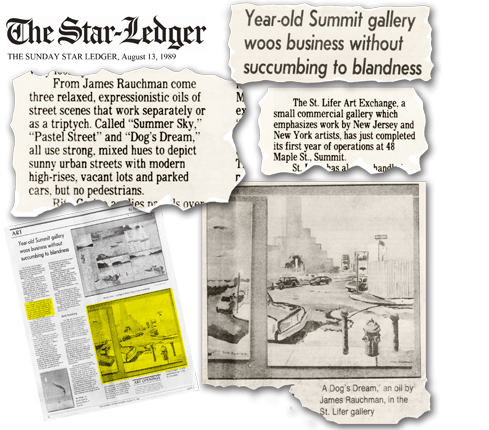Press
Art Review: James Rauchman, River Arts
By PAMELA POLSTON

"The Dance"
The ancients invented portraiture, but it wasn't until the Middle Ages, apparently, that anyone thought to paint, draw or etch their own image. That's because "it was an age preoccupied with personal salvation and self-scrutiny," according to James Hall, author of The Self-Portrait: A Cultural History. We can draw a straight line to the photographic selfie of the current era, in which we are preoccupied with self-documentation and "likes."
Over the centuries, countless artists have created self-portraits — and why not? The model is free and nearly always available. Painting one's face again and again is, after all, great practice for getting the nose just right, capturing the fall of light upon the cheek and so forth.
River Arts showcases introspective local artists
Laughing and painting through the pain
Avalon Styles-Ashley | Staff Writer Aug 12, 2021

Visitors crowd into the gallery at River Arts in Morrisville to see artist Jamie Rauchman’s self-portrait collection.
Photo by Gordon Miller
Broken into chunks, stitched onto the head of Frankenstein’s monster, glimpsed in a mirror: different versions of Jamie Rauchman’s face is on nearly every wall of River Arts’ upstairs gallery in Morrisville.
He’s added to this collection of strange, swirling, sometimes comical yet stylistically beautiful self-portraits over 40 years as a full-time artist, amid a career of other muses. The paintings came “urgently, but sporadically,” he said, but he’s never unveiled them until now.
Rauchman, who lives on Randolph Road with one foot in Stowe and the other in Morrisville, is one of two artists featured in the community art center’s first in-person gallery opening in over a year and a half. Fellow Vermont artist Nitya Brighenti’s work in the center’s downstairs gallery takes another approach to self-portraiture, playing with boundaries and the ineffable borders of color and light.
Thinking beyond New York City
August 21, 2021 4:44 pm

Randolph Road, 2020, oil on canvas, 48 × 48 inches

Winter, oil on canvas, 48 × 48 inches
Jamie Rauchman is the only artist I was familiar with before my visit to SQD. He used to have a studio in NYC, in Morningside Heights, where I visited him before he moved up to Vermont. Whether painting the figure, still life, landscape, abstraction, or some combination, the versatile Rauchman remains, as he has always been, a skillfully exuberant painter who spills his love of life onto his canvases. The vivid paintings on display have a touch of Charles Burchfield’s landscape weirdness – pointy clouds, undulating brushwork – but they belong completely to Rauchman, who has found an engaging new subject in the hills and farmland of Vermont.
ART TALKS with Jamie Rauchman
This is an interview with me (conducted in 2014 and edited and broadcast in 2015),
for a show on Public Access TV in New York City, called “Art Talks” where artists are
given the chance to show and talk about their work.


The eternal hope of Cubans, painted by a New Yorker
MARCH 30, 2018 19:07
Havana, Mar 30 (efe-epa).- The eternal hope of Cubans that something will happen to make their life easier has been captured in watercolors by New York artist James Rauchman, a Cuba lover now exhibiting in Havana the portraits of his friends on the island under the title "Esperando," which translates as both waiting and hoping. Read more.

"Esperando", la exposición que deleita a los cubanos y de la cual son protagonistas
Las obras se exponen en la pared negra de la Fábrica de Arte Cubano
La eterna espera de los cubanos de que ocurra algo que haga su vida más fácil ha sido capturada en forma de acuarelas por el artista neoyorquino James Rauchman, un enamorado de Cuba que ahora expone en La Habana los retratos de sus amigos de la isla bajo el título "Esperando".
Los retratos se exponen desde esta semana sobre la imponente pared negra de la Fábrica de Arte Cubano (FAC), un espacio en el que los tonos alegres de las acuarelas y de la ropa de los retratados contrastan con el fondo oscuro, pero también con los gestos adustos de sus protagonistas.
Sin embargo, Rauchman siempre percibió como denominador común de los cubanos, "una increíble perseverancia, la voluntad de encontrar la felicidad en los detalles más simples de la vida, y la aceptación del hecho de que a veces la vida puede ser difícil".
Rauchman llegó a Cuba por primera vez en 1997 y desde entonces ha regresado en 40 ocasiones, aunque la serie expuesta la pintó entre 2004 y 2006 y una selección fue expuesta en la Bienal de La Habana ese último año.

Studio Visit: James Rauchman
January 6, 2018 / Contributed by Sharon Butler

We were born several years apart, but James Rauchman and I have the same severe late-February birthday. Babies born in the northeast during the dark, cold winter months are a hearty breed, and when I stopped by his Morningside studio in December, he and his partner had just bought a house in Vermont, where the weather is even more punishing than it is in New York. Nevertheless, he’s eager to turn the outbuilding on the property into a studio and begin painting. His remarkably fluent, expressive, and eclectic paintings document his life and freely cross genre boundaries. Some are realistic paintings from life, as in a series depicting his studio and images of travels in Cuba, while others record surreal fantasies of his interior life and still others are small-scale abstractions. His most recent canvases feature Riverside Park at night.












